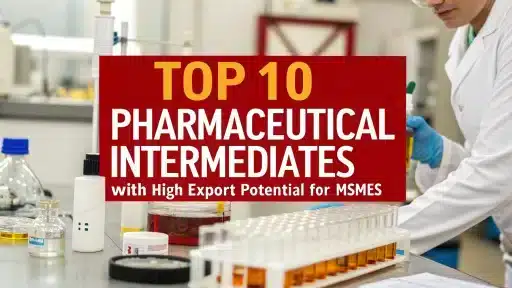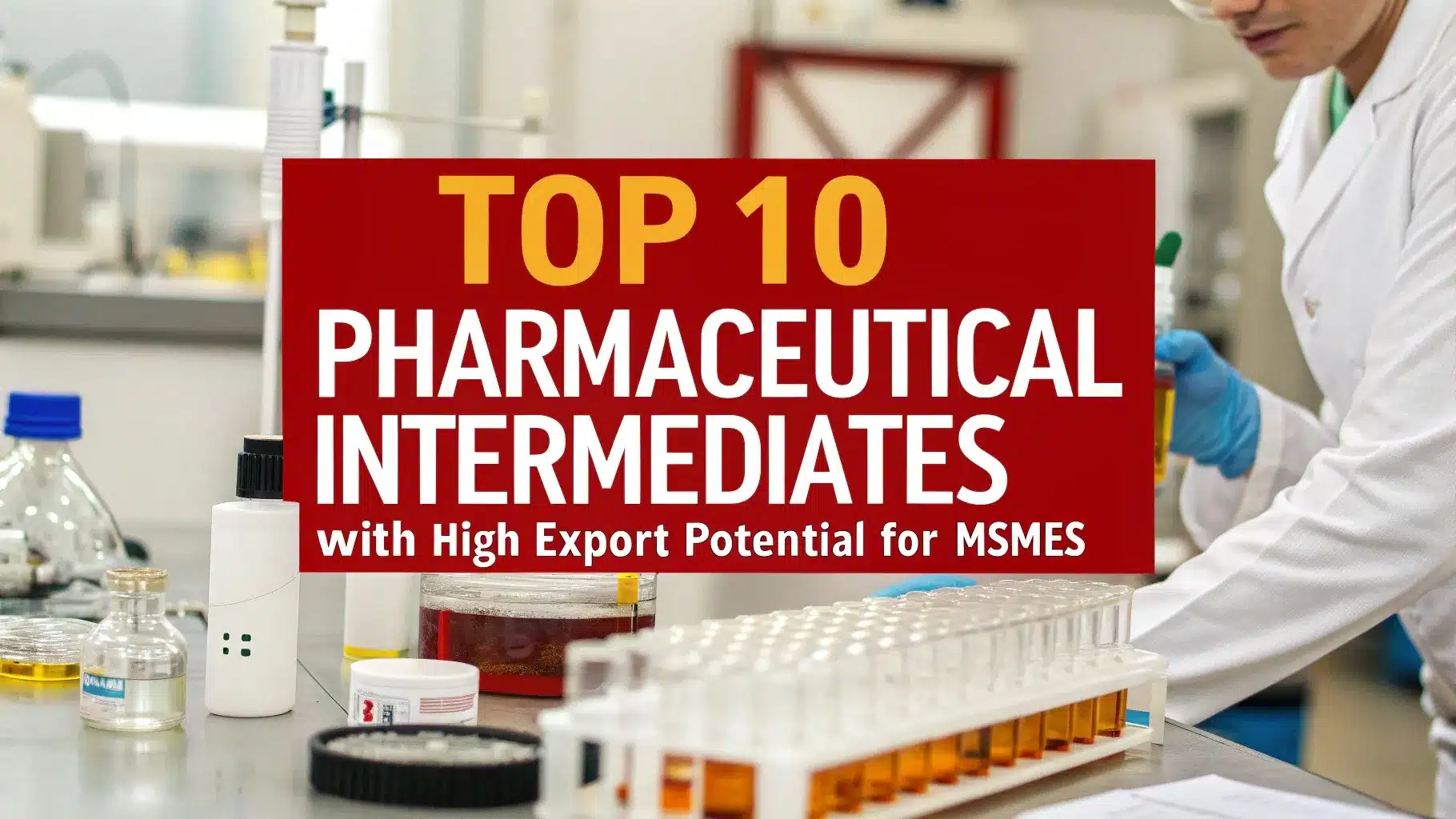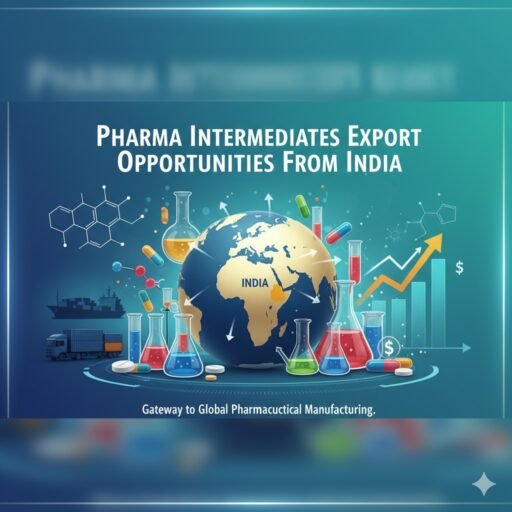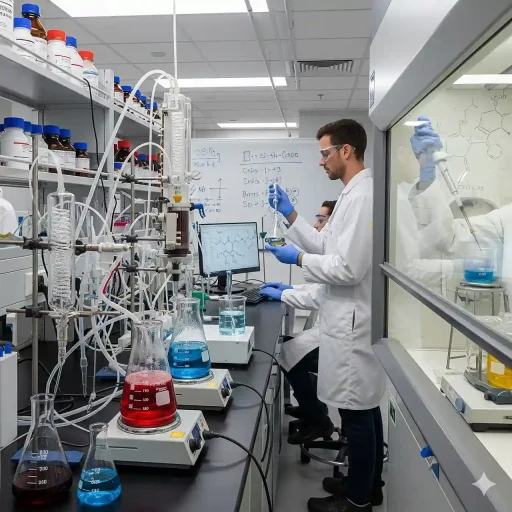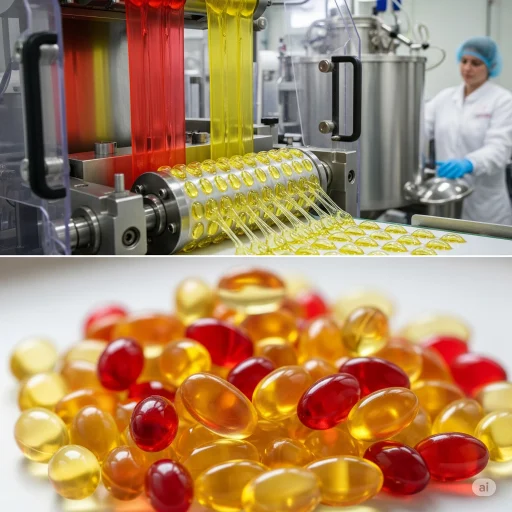A Sunrise Opportunity for MSMEs in Pharmaceutical Intermediates Manufacturing
India is known internationally for its generic drug production. For micro, small, and medium enterprises (MSMEs), there is a huge potential for exporting and manufacturing Pharmaceutical intermediates, while large pharmaceutical companies continue to control API exports. Intermediates are in high demand and and with the current geopolitical tensions focusing on diversifying supply chains, India makes for a perfect hire due to its low operational costs, skilled workers, and developed chemical industry.
Unlike the other domains, pharmaceutical intermediates have lower regulation, require lower capital as well as investment and have a steady demand globally making it ideal for MSMEs, startups and entrepreneurs. This article provides insights about the high demand intermediates, their market demand trends, production details, and the role of MSMEs in harnessing this potential.
Related: Top Innovations in Pharmaceutical Manufacturing Technologies
1. p-Aminophenol – The Backbone of Paracetamol Manufacturing
p-Aminophenol belongs to one of the most important pharmaceutical intermediates in the world. There is a global market for paracetamol and, therefore for p-aminophenol as well.
The process usually starts with the production of nitrophenol by the nitration of phenol, which is further p-aminophenol by catalytic hydrogenation. The reaction takes place with metal catalysts at fixed temperature and pressure conditions. There is demand in Europe and Latin America and even in some parts of Southeast Asia where formulation units seek dependable outsourcing to reduce costs without sacrificing quality.
2. Isatoic Anhydride – Essential for Anti-Infectives and Antispasmodics Patients
This intermediate is highly relevant in the production of derivatives of anthranilic acid which are used as the backbone of various drugs in anti-inflammation and anti-infection medicine. We can observe that Indian chemical companies have specialized in the production of this intermediate, positioning them well for scale-up by MSMEs.
Isatoic anhydride is usually synthesized from anthranilic acid and phosgene or triphosgene, followed by a recrystallization step. New green synthesis methods and encapsulated reactors are more eco-friendly, although the older methods were quite toxic. MSMEs focusing on benzimidazole derivatives or NSAIDs can produce this intermediate in bulk for export.
3. 4-Aminophenol-3-sulfonic Acid – Multipurpose Anti-Infective Ingredient
4-Aminophenol-3-sulfonic acid remained a dye intermediate for years, but it is now finding more use in disinfectants and antiseptic formulations in pharmaceuticals. The multifunctional nature of the compound makes it very appealing to manufacturers and traders as an anti-infective agent for diverse industries.
P-aminophenol’s sulfonation reaction yields this compound. For reproducibility, pH control during sulfonation, sulfonation temperature, and crystallization time must be controlled.
4. 3,5-Dinitrosalicylic Acid – Diagnostic Applications for Biotech and Labs
3,5-Dinitrosalicylic acid is used extensively in the creation of colorimetric enzyme assays and diagnostics, particularly in diabetes detection. Dinitrosalicylic acid is commercially available in countries with developing medical research systems.
The manufacturing process requires the nitration of salicylic acid within a controlled acidic environment. The reaction is exothermic and thus requires cooling systems alongside safety infrastructure. There seems to be strong demand for this molecule among MSMEs serving diagnostic kit manufacturers and biotech exporters.
5. Phenacetin Intermediate – A Rediscovered Precursor for Steroidal APIs
This intermediary is still procured in some Latin American and Eastern European regions due to their older formulation pipelines.
With the use of p-aminophenol, the process starts with its acetylation in a solvent medium with an acidic catalyst. The solid obtained undergoes filtration, washing, and drying. Exporters with connections to legacy pharma producers or grey-market formulators have steady demand opportunities in this niche.
Related: Empowering India’s Growth Through Pharmaceutical Intermediates & API Production
6. Cyclohexanone – Solvent and Precursor for Adipic Acid and APIs
Used in both the pharmaceutical and polymer industries, Cyclohexanone is a well-established chemical intermediate. Adipic acid, which further leads to nylon production, and some tranquilizers and sedatives, uses cyclohexanone as a vital component.
The method for obtaining it includes air oxidation of cyclohexane or dehydrogenation of cyclohexanol, followed by distillation. MSMEs with dual markets (pharma and textile) can capitalize on this solvent that is frequently imported, maximizing profit with its dual-market applications.
7. Phthalic Anhydride – A Key Link in the Painkiller and Resin Chains
Phthalic anhydride is a key feedstock for some non-steroidal anti-inflammatory drugs (NSAIDs) such as ibuprofen and naproxen and also strengthens the expanding markets of polyester resins and plasticizers.
This compound is made through the oxidation of o-xylene in vapor-phase reactors with vanadium pentoxide catalysts. This is a well-established process, and the product has both industrial and medical-grade markets. India is often a supplier of these regions due to competitive rates, especially Europe, North Africa, and Central Asia.
8. 2,4-Dichlorophenoxyacetic Acid (2,4-D) – Agrochemical Meets Pharma
2,4-D is an herbicide but also serves as an intermediate for therapeutic drugs used in autoimmune and inflammatory diseases, especially those still in clinical trials. As some biotech companies look into diverse applications of the product, its utilization in pharma is expected to grow.
Manufacture consists of the phenoxyacetic acid chlorination with chlorine-containing reagents in alkaline medium. Agro-pharma crossovers keep demand steady, allowing exporters to diversify their client base.
9. Adipic Acid – From Neurology to Nylon
Analytical labs produced gabapentin, a primary medication for treating a wide range of neurological disorders by using multistep synthesis techniques. One of the key raw materials, adipic acid, is in high demand not only in the pharmaceutical sector but also in polyamide and synthetic textile industries.
The typical pathway involves the oxidation of cyclohexanol and cyclohexanone with nitric acid. Then the product is purified. Due to post-pandemic anxiety and neurological therapy necessitating gabapentin prescription, the raw material has high export demand and considerable profit margins.
10. Benzoyl Peroxide – A Safe Bet in Dermatological APIs
Benzoyl Peroxide is still topical used all over the world for treating acne and other mild dermatological conditions. While the prepared dosage forms have tight controls, the compliance burden for the intermediate is somewhat lower.
Its manufacture involves the reaction of benzoyl chloride with hydrogen peroxide under basic conditions. The US and EU markets for skincare products are huge, and this simpler process enables MSMEs meeting export demand without significant capital investments.
What Are the Considerations for MSMEs Manufacturing?
The manufacture of pharmaceutical intermediates typically entails the synthesis, purification, and crystallization in reactors. Since there is no need for rigorous final testing and clinical validation for the end product, these processes are less complex than full API manufacturing. Modular plants comprising jacketed vessels, rotary evaporators, and temperature controlled drying units can be used by MSMEs.
While contract QC labs and third-party certifying agencies can streamline many processes for Export-Ready facilities, there are still critical factors such as packaging, MSDS documentation, and REACH registrations for EU-bound shipments that still need to be handled in-house. Additionally, quality assurance is also critical, and the levels of pharmacopeial standards cited need to be compliant with the purity, moisture content and impurity profile.
Reasons Why Pharmaceutical Intermediates Are Best for MSMEs
Pharmaceutical intermediates are situated precisely in the sweet spot:
- Regulations are less stringent than for APIs or formulations.
- Pharmaceutical intermediates have greater overseas demand than generic chemicals.
- They allow entry into the pharma value chain without heavy clinical spending.
- Capability to cater to pharma and allied sectors.
- Opportunities for innovation in process chemistry and reduction of impurities.
These reasons make the category very appealing for Indian MSMEs that seek to position themselves as global suppliers.
For more information check our Project Reports
How NPCS Assists With Your Pharma Intermediate Manufacturing Needs
NIIR Project Consultancy Services (NPCS) specializes in assisting entrepreneurs and industrialists to set up intermediate pharmaceutical manufacturers agnostically, as MSMEs.
They specialize in working with regional entrepreneurs for creating Market Survey cum Detailed Techno Economic Feasibility Reports, which strategically help MSMEs identify crucial demand drivers and assess operational profitability.
NPCS considers all aspects of materials, equipment, and processes in manufacturing automation as well as stringent quality control of final products.
NPCS aids in sound investment-disburnsement allocation for segment targeted thorough detailed feasibility analysis and assisted decision-making.
Conclusion: A Local Edge in a Global Market
India possesses both the infrastructure and intellect to spearhead in exporting pharmaceutical intermediates with the change in global demand and rising regulatory standards. For startups and MSMEs, the route is straightforward—choose suitable intermediates, construct modular and compliant plants, and support the global value chain with precision, efficiency, and unwavering consistency.
As India’s small manufacturers position themselves within the shifting global pharmaceutical supply chain, they have the opportunity to transform from being mere suppliers to becoming key strategic partners. Backed by NPCS’s expert guidance, your entry into this high-growth sector can be streamlined for efficiency, sustainability, and profitability.

